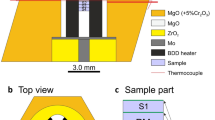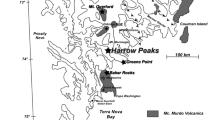Abstract
The incorporation of hydrogen in mantle olivine xenocrysts from the Udachnaya kimberlite pipe was investigated by Fourier-transform infrared spectroscopy and secondary ion mass spectrometry (SIMS). IR spectra were collected in the OH stretching region on oriented single crystals using a conventional IR source at ambient conditions and in situ at temperatures down to −180°C as well as with IR synchrotron radiation. The IR spectra of the samples are complex containing more than 20 strongly polarized OH bands in the range 3,730–3,330 cm−1. Bands at high energies (3,730–3,670 cm−1) were assigned to inclusions of serpentine, talc and the 10 Å phase. All other bands are believed to be intrinsic to olivine. The corresponding point defects are (a) associated with vacant Si sites (3,607 cm−1 E || a, 3,597 E || a, 3,571 cm−1 E || c, 3,567 E || c, and 3,556 E || b), and (b) with vacant M1 sites (most of the bands polarized parallel to a). From the pleochroic behavior and position of the OH bands associated with the vacant M1 sites, we propose two types of hydrogen—one bonded to O1 and another to O2, so that both OH vectors are strongly aligned parallel to a. The O2–H groups may be responsible for the OH bands at higher wavenumbers than those for the O1–H groups. The multiplicity of the corresponding OH bands in the spectra can be explained by different chemical environments and by slightly different distortions of the M1 sites in these high-pressure olivines. Four samples were investigated by SIMS. The calculated integral molar absorption coefficient using the IR and SIMS results of 37,500±5,000 L mol H2O cm−2 is within the uncertainties slightly higher than the value determined by Bell et al. (J Geophys Res 108(B2):2105–2113, 2003) (28,450±1,830 L mol H2O cm−2). The reason for the difference is the different distributions of the absorption intensity of the spectra of both studies (mean wavenumber 3,548 vs. 3,570 cm−1). Olivine samples with a mean wavenumber of about 3,548 cm−1 should be quantified with the absorption coefficient as determined in this study; those containing more bands at higher wavenumber (mean wavenumber 3,570 cm−1) should be quantified using the value determined by Bell et al. (J Geophys Res 108(B2):2105–2113, 2003).









Similar content being viewed by others
Notes
It is a common sense to express the hydroxyl concentration in terms of ppm by wt water
References
Bai Q, Kohlstedt DL (1993) Effects of chemical environment on the solubility and incorporation mechanism for hydrogen in olivine. Phys Chem Miner 19:460–471
Bell DR, Rossman GR, Maldener J, Endisch D, Rauch F (2003) Hydroxide in olivine: a quantitative determination of the absolute amount and calibration of the IR spectrum. J. Geophys Res 108(B2):2105–2113
Beran A (1969) Über OH-Gruppen in Olivin. Österr Akad Wiss, Math Naturw Kl Anzeiger:73–74
Beran A, Putnis A (1983) A model of the OH positions in olivine, derived from infrared-spectroscopic investigations. Phys Chem Miner 9:57–60
Braithwaite JS, Sushko PV, Wright K, Catlow CRA (2002) Hydrogen defects in forsterite: a test case for the embedded cluster method. J Chem Phys 116:2628–2635
Braithwaite JS, Wright K, Catlow CRA (2003) A theoretical study of the energetics and IR frequencies of hydroxyl defects in forsterite. J Geophys Res 108(B6):2284
De Hoog JC (2004) An empirical calibration of an Al-in-olivine geothermometer for mantle-derived materials. EOS Trans Am Geophys Union Suppl 85:V41C-1399
Demouchy S, Mackwell S (2003) Water diffusion in synthetic iron-free forsterite. Phys Chem Miner 30:486–494
Khisina NR, Wirth R, Andrut M, Ukhanov AV (2001) Extrinsic and intrinsic mode of hydrogen occurrence in natural olivines: FTIR and TEM investigation. Phys Chem Miner 28:291–301
Kitamura M, Kondoh S, Morimoto N, Miller GH, Rossman GR (1987) Planar OH-bearing defects in mantle olivine. Nature 328:143–145
Kohlstedt DL, Mackwell SJ (1998) Diffusion of hydrogen and intrinsic point defects in olivine. Z Phys Chem 207:147–162
Kohlstedt DL, Keppler H, Rubie DC (1996) Solubility of water in the α, β, and γ phases of (Mg, Fe)2SiO4. Contrib Mineral Petrol 123:345–357
Kurosawa M, Yurimoto H, Sueno S (1997) Patterns in the hydrogen and trace element compositions of mantle olivines. Phys Chem Miner 24:385–395
Lemaire C, Kohn SC, Brooker RA (2004) The effect of silica activity on the incorporation mechanisms of water in synthetic forsterite: a polarised infrared spectroscopic study. Contrib Mineral Petrol 147:48–57
Libowitzky E, Beran A (1995) OH defects in forsterite. Phys Chem Miner 22:387–392
Libowitzky E, Rossman GR (1997) An IR absorption calibration for water in minerals. Am Mineral 82:1111–1115
Mainprice D, Tommasi A, Couvy H, Cordier P, Frost DJ (2005) Pressure sensitivity of olivine slip systems and seismic anisotropy of Earth’s upper mantle. Nature 233:731–733
Maldener J, Hösch A, Langer K, Rauch F (2003) Hydrogen in some natural garnets studied by nuclear reaction analysis and vibrational spectroscopy. Phys Chem Miner 30:337–344
Matsyuk SS, Langer K (2004) Hydroxyl in olivines from mantle xenoliths in kimberlites of the Siberian platform. Contrib Mineral Petrol 147:413–437
Matveev S, O’Neill HSC, Ballhaus C, Taylor WR, Green DH (2001) Effect of silica activity on OH-IR spectra of olivine: implications for low-aSiO2 mantle metasomatism. J Petrol 42:721–729
Matveev S, Portnyagin M, Ballhaus C, Brooker R, Geiger CA (2005) FTIR spectrum of phenocryst olivine as an indicator of silica saturation in magmas. J Petrol 46:603–614
Miller GH, Rossman GR, Harlow GE (1987) The natural occurrence of hydroxide in olivine. Phys Chem Miner 14:461–472
Nakamura A, Schmalzried H (1983) On the nonstoichiometry and point defects of olivine. Phys Chem Miner 10:27–37
Paterson (1982) The determination of hydroxyl by infrared absorption in quartz, silicate glasses and similar materials. Bull Minéral 105:20–29
Sykes D, Rossman GR, Veblen DR, Grew ES (1994) Enhanced H and F incorporation in borian olivine. Am Mineral 79:904–908
Wiedenbeck M, Rhede D, Lieckefett R, Witzki H (2004) Cryogenic SIMS and its applications in the earth sciences. Appl Surf Sci 231–232:888–892
Zhao YH, Ginsberg SB, Kohlstedt DL (2004) Solubility of hydrogen in olivine: dependence on temperature and iron content. Contrib Mineral Petrol 147:155–161
Acknowledgements
We thank U. Schade who helped with the synchrotron measurements at Bessy II, Berlin, Germany, R. Schulz for conducting the experiments in the rapid-quench gas flow furnace and M. Wiedenbeck for helpful discussions and suggestions concerning the SIMS measurements. The comments and suggestions of A. Beran and an anonymous reviewer helped to clarify and improve the manuscript. The grants 436 UKR 17/15/03 and -/04 for S.S. Matsyuk and 436 RUS 17/75/03 and -/76/04 for N. Khisina by Deutsche Forschungsgemeinschaft DFG are gratefully acknowledged.
Author information
Authors and Affiliations
Corresponding author
Rights and permissions
About this article
Cite this article
Koch-Müller, M., Matsyuk, S.S., Rhede, D. et al. Hydroxyl in mantle olivine xenocrysts from the Udachnaya kimberlite pipe. Phys Chem Minerals 33, 276–287 (2006). https://doi.org/10.1007/s00269-006-0079-9
Received:
Accepted:
Published:
Issue Date:
DOI: https://doi.org/10.1007/s00269-006-0079-9




